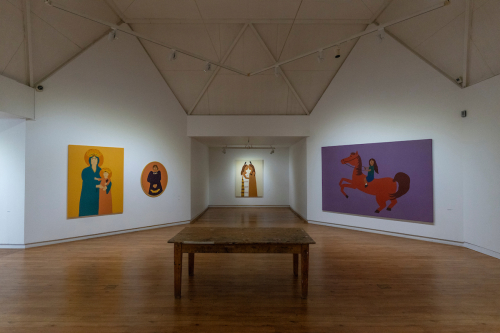
Ayesha Green, To the best of my knowledge, at Te Whare Toi o Heretaunga - Hastings Art Gallery.
Tucked away, above a dairy on Karangahape Road, one of the rising stars of Aotearoa’s art world is on the floor, working on a huge new canvas. Once an apartment, the two rooms at the top of the narrow, winding staircase have been used as artist studios since the 1990s, and are now home to award-winning painter, Ayesha Green, and her friend and fellow artist Yolunda Hickman.
“The first artist to occupy this space was actually [renowned photographer] Ann Shelton and her girlfriend,” Ayesha says. “She told me this great story where they were walking along K Road and they were looking for studio spaces and they saw an empty spot upstairs.”
The butcher below, while somewhat confused at first, agreed to lease the space to Shelton and her partner, and the studio has been home to artists since. “My friend John Ward Knox had his studio here, my friend Johl Dwyer, Sarah Smuts-Kennedy, Heidi Brickell. So many artists have come through, so I’m really lucky.”
Ayesha is a deep thinker and a natural story-teller, using her work to examine themes of nationalism, colonisation and Te Ao Māori.
“My painting is about the stories that we tell ourselves about ourselves, and using painting as a type of visual language that can change narratives of what we might think of ourselves as people within New Zealand or Aotearoa,” she says.
“My work is a kind of service and that service interrelates and acts in two different ways. One is a service to my iwi and being able to tell stories of what it might mean to be a Ngāi Tahu and a Ngāti Kahungunu woman. But there’s also another service I do, which is to allow people to see the different ways that Māori might live or to understand the nation in a broader way.”
She uses tessellating botanical elements, usually clothing or fabric items, to anchor her work in a specific place – native plants for Aotearoa, international plants for elsewhere.
When asked about her distinctive cartoon style, Ayesha says she never knows how to answer this question. “I sort of just fell into it,” she laughs, saying she “literally cannot paint realistic”, before going on.
Ayesha has had a busy year – her work was in landmark Auckland Art Gallery show, Toi Tū, Toi Ora, and at Auckland Art Fair. Soon after, she won the Rydal Art Prize, a national contemporary painting award which comes with a $20,000 prize and a solo exhibition at Tauranga Art Gallery next year. The win, she says, was a complete shock.
“That kind of monetary prize is life-changing. And being able to develop a really big show for Tauranga Art Gallery is really exciting,” she says. “I want to do the most ambitious show ever… These types of opportunities really push your practice forward because there’s room to grow and experiment.”
But first, she has an exhibition at Hastings Art Gallery, To the Best of my Knowledge, opening in August.
“A lot of my work looks at the role that knowledge plays in creating these stories that we understand, or how we come to know things in the world. But also who gets to create that knowledge and then also disperse it through the world,” she says. “So this show is using Hukarere School as a way to think through what education looked like for Māori women at the time of colonisation and how those native schools functioned.”
She used a book, Hukarere and the politics of Māori girls’ schooling by Kuini Jenkins and Kay Morris Matthews, as the basis of her research, and has painted a number of portraits of Hukarere students.
“Māori girls would learn how to live and work as a pākehā woman [at Hukarere], and then they would get sent back to the kainga [home], which was generally in rural areas, and teach the rest of the family what to do,” Ayesha says.
But she says many Hukarere students went on to use their knowledge of pākehā systems to create new spaces for Māori, like the kohanga reo movement and the Māori Women’s Welfare League. “They’ve really come out fighting for Māori… the Trojan horse flips the other way – these Māori girls were sent out into a pākehā world and then started reinstating tīkanga Māori back into the world,” Ayesha says.
“A lot of this show is portraiture of Māori women that acts as acknowledgement of the work that has been done and a way to give back agency to these Māori women – not that their agency was lost, but to give agency to the story of native schooling. I always use portraiture as a way to celebrate the person or the sitter.”
To the Best of my Knowledge was exhibited at Te Whare Toi o Heretaunga - Hastings Art Gallery from August 14 until November 28, 2021. This essay was written by Rosie Dawson-Hewes and first published in the August-September 2021 issue of Homestyle.
Disclaimers and Copyright
While every endeavour has been taken by the Hastings City Art Gallery to ensure that the information on this website is
accurate and up to date, Hastings City Art Gallery shall not be liable for any loss suffered through the use, directly or indirectly, of information on this website. Information contained has been assembled in good faith.
Some of the information available in this site is from the New Zealand Public domain and supplied by relevant
government agencies. Hastings City Art Gallery cannot accept any liability for its accuracy or content.
Portions of the information and material on this site, including data, pages, documents, online
graphics and images are protected by copyright, unless specifically notified to the contrary. Externally sourced
information or material is copyright to the respective provider.
© Hastings City Art Gallery - www.hastingscityartgallery.co.nz / +64 6 8715095 / hastingsartgallery@hdc.govt.nz